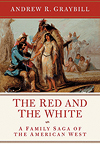The Red and the White: A Family Saga of the American West, by Andrew R. Graybill, Liveright, New York, 2013, $28.95
On the bitterly cold dawn of January 23, 1870, Major Eugene Baker and his 2nd U.S. Cavalry command mistakenly attacked a peaceful Piegan Blackfoot Indian encampment on the Marias River in  Montana Territory. The soldiers killed between 170 and 220 Indians, eight when they were recaptured after they had tried to escape. “No, don’t use your guns,” ordered Lieutenant Gus Doane. “Get axes and kill them one at a time.” Another of Baker’s lieutenants called the fight “the greatest slaughter of Indians ever made by U.S. troops,” but today it’s almost completely forgotten. The massacre was sparked by the murder of Malcolm Clarke, an ex-fur trader who had married a Piegan woman and was killed by his wife’s cousin.
Montana Territory. The soldiers killed between 170 and 220 Indians, eight when they were recaptured after they had tried to escape. “No, don’t use your guns,” ordered Lieutenant Gus Doane. “Get axes and kill them one at a time.” Another of Baker’s lieutenants called the fight “the greatest slaughter of Indians ever made by U.S. troops,” but today it’s almost completely forgotten. The massacre was sparked by the murder of Malcolm Clarke, an ex-fur trader who had married a Piegan woman and was killed by his wife’s cousin.
Andrew R. Graybill, director of the Clements Center for Southwest Studies at Southern Methodist University, does more than tackle the story of this tragic event. The Red and the White follows the Clarke family through several generations and examines Indian-white interracial marriages, beginning with Malcolm Clarke and his marriage to Coth-co-co-na in 1844. It offers a fascinating look at those “peoples in between” and their roles in the 19th- and early 20th-century America. “The world of Coth-co-co-na and Malcolm Clarke—one in which individuals of mixed ancestry stood near the pinnacle of the social order on the Upper Missouri, serving as brokers between white and native societies—was washed away in the course of a single generation,” writes Graybill.




